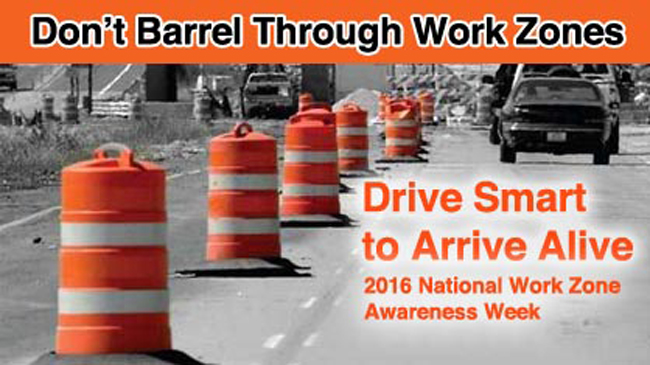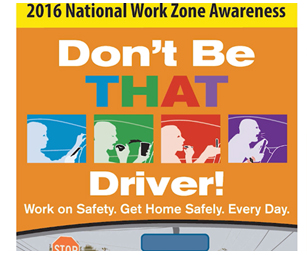

ITD reminds motorists to drive safely in work zones
April 11-15 is national Work Zone Awareness Week, but awareness extends beyond the weekSafer driving means safer work zones. Not just safer for construction workers, but also safer for motorists.
The person working behind the orange traffic cone is at risk, as is the worker directing motorists with a “stop-go” traffic paddle — but so too is the person behind the wheel, or the passenger behind the windshield. In fact, 85 percent of those killed in work-zone crashes are motorists or their passengers.
The Idaho Transportation Department (ITD) asks motorists to drive carefully through work zones. Each year, the Federal Highway Administration, ITD and other state departments of transportation draw special attention to safe driving in or near work zones during Work Zone Awareness Week, held nationwide this April 11-15. The timing coincides with the start of construction season throughout the U.S.
This year's theme, "Don't Be That Driver!" reinforces the message that motorists should be constantly alert and prepared for dynamic changes in and around work zones. 
Driver-related factors that affect work zone crashes include speeding, in-vehicle distractions and inattentive or aggressive driving. The most frequently occurring type of work zone crash is a rear-end collision, so paying constant attention to traffic ahead and maintaining an adequate following distance is important in avoiding them. National studies indicate that cell phone use increases the rate of rear-end collisions, decreases brake time by 18 percent, and causes a 25-percent increase in erratic driving. Nationwide in 2014, distracted driving was a factor in 16 percent of fatal crashes in work zones, while speeding was a factor in 29 percent.
Distracted driving is any activity that diverts a person's attention away from the primary task of driving. There are three main types of distraction:
Visual – taking your eyes off the road.
Manual – taking your hands off the wheel.
Cognitive – taking your mind off what you are doing.
Nationally, there were 669 work zone traffic-related fatalities in 2014, the last full year of statistics, according to FARS, the Fatality Automated Reporting System. In addition, there were more than 31,000 work zone injuries that year.
In Idaho, there have been 2,039 crashes in work zones in the last five years (2010-2014), accounting for nine motorist fatalities. Four highway workers were injured as a result.
“We urge drivers to give their full attention and use extreme caution when passing through these areas so they can arrive at their destination safely and construction workers can return home to their loved ones,” said ITD Chief Deputy Scott Stokes.
Stokes encouraged a common-sense approach to driving in work zones by offering drivers a few simple questions to answer for themselves.
Ask yourself if you:
- Devote your full attention to driving — nothing is more important.
- Checked 511 to see if there will be construction or heavy equipment on your route, or a changed traffic pattern?
- Drive at the proper speed limit and follow the directions of signs and flaggers? Are you slowing down for gravel surfaces, especially if riding a motorcycle?
- Buckled up, driving attentively, and avoiding distractions such as cell-phone use?
- Are being patient with delays that may happen? Some projects may have delays of up to 15 minutes, so consider adjusting your travel schedule accordingly.
“Attentive driving in or near work zones will help ensure the safety of drivers, passengers and construction workers,” Stokes added.
Published 04-08-16